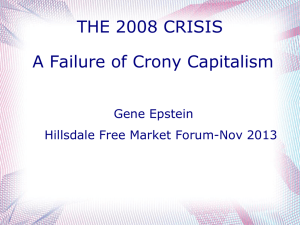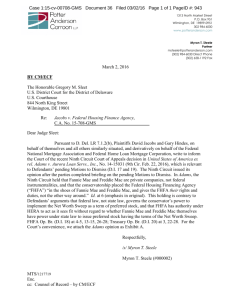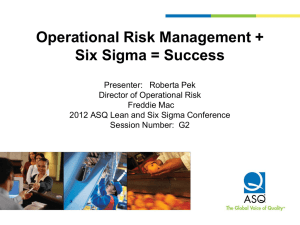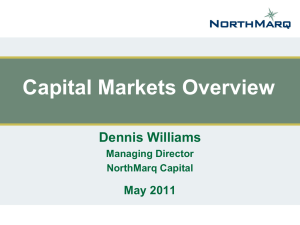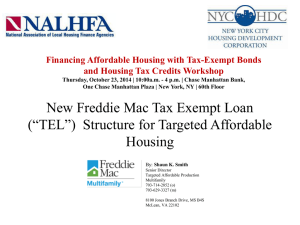GSE Reform: Are the Multifamily Risk Sharing Programs
advertisement
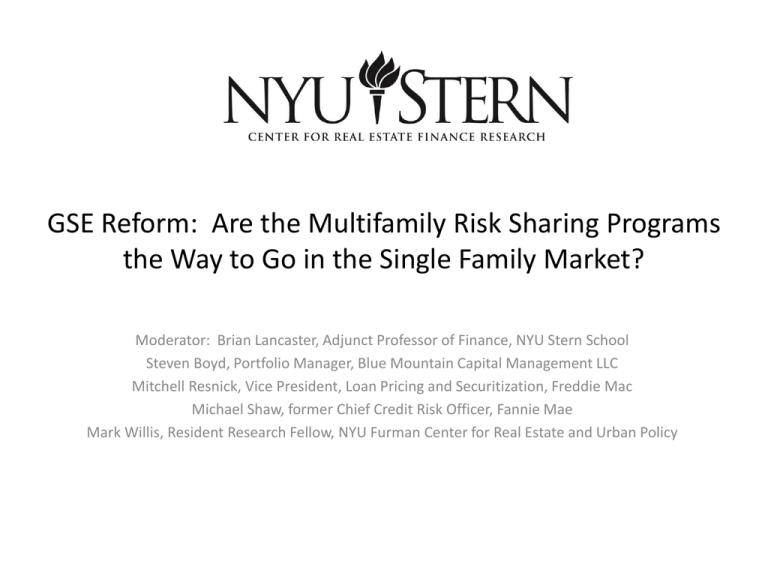
GSE Reform: Are the Multifamily Risk Sharing Programs the Way to Go in the Single Family Market? Moderator: Brian Lancaster, Adjunct Professor of Finance, NYU Stern School Steven Boyd, Portfolio Manager, Blue Mountain Capital Management LLC Mitchell Resnick, Vice President, Loan Pricing and Securitization, Freddie Mac Michael Shaw, former Chief Credit Risk Officer, Fannie Mae Mark Willis, Resident Research Fellow, NYU Furman Center for Real Estate and Urban Policy Fannie Mae Multifamily Serious Delinquency Rates Multifamily 60+ Day SDQ rates (2006 - Q1 2013) 14% 12% 10% 8% 6% 4% 2% 0% Fannie Mae Fannie Mae DUS Freddie Mac Life Insurers CMBS All FDIC Insured Institutions Commercial Banks (CMB) $10B+ in assets All Other FDIC Institutions (Less CMB with 10B+) 2006 0.08% 0.09% 0.05% 0.02% 0.70% 0.53% 0.81% 0.40% 2007 0.08% 0.08% 0.02% 0.01% 1.04% 0.76% 0.70% 0.79% 2008 0.30% 0.24% 0.01% 0.07% 2.40% 1.77% 1.43% 2.07% 2009 0.63% 0.39% 0.20% 0.19% 8.06% 4.43% 5.33% 3.51% 2010 0.71% 0.56% 0.26% 0.19% 13.25% 3.74% 4.09% 3.39% 2011 0.59% 0.50% 0.22% 0.13% 11.66% 2.53% 2.46% 2.59% 2012 0.24% 0.18% 0.19% 0.06% 10.03% 1.56% 1.46% 1.68% Fannie Mae’s Multifamily DUS SDQ rates remain below MF CMBS and FDIC insured institutions Source: Fannie Mae, Freddie Mac, CMBS-MF (Trepp), Life Insurers (ACLI) and Banks (FDIC). Note: FDIC Insured Institutions data reflect 90+ day delinquency rates. Delinquency calculation may vary by institution. Q1 2013 0.39% 0.34% 0.16% 0.01% 9.08% 1.35% 1.24% 1.48% Freddie Mac Multifamily Business Results Basis Points Delinquency Rates 1,600 1,400 1,200 1,000 800 600 400 200 0 Freddie Mac (60+ Day) Fannie Mae (60+ Day) MF CMBS Market (60+ Day) ACLI (60+ Day) FDIC Insured Institutions (90+ Day) 1Q08 3Q08 1Q09 3Q09 1Q10 3Q10 1Q11 3Q11 1Q12 3Q12 1Q13 1Q12 3Q12 1Q13 Basis Points Porfolio Delinquency Rates (GSE) 90 80 70 60 50 40 30 20 10 0 Freddie Mac (60+ Day) Fannie Mae (60+ Day) 1Q08 3 3Q08 1Q09 3Q09 1Q10 3Q10 1Q11 3Q11 Sources: FDIC Insured Institutions: FDIC Quarterly Banking Profile - Loan Performance Data MF CMBS Market: TREPP. 60+ days, in foreclosure, REO, or non-performing balloons Fannie Mae: Delinquency rate from SEC filing Freddie Mac: Multifamily delinquency performance is based on the UPB of the total Multifamily mortgage portfolio ACLI: First Quarter 2013 ACLI Investment Bulletin Freddie Mac Multifamily Business Results (continued) 12 Basis Points 10 8 6 4 2 0 1 Graph shows Freddie Mac Multifamily portfolio net charge-offs . Data point for each quarter reflects net charge-offs for a rolling twelve month period. For example, the 2Q11 value equals the sum of net charge-offs in 3Q10, 4Q10, 1Q11 and 2Q11 divided by the average balance of the multifamily loan and guarantee portfolios during 2Q11. Source: Freddie Mac 4 Fannie Mae Multifamily DUS® Risk Sharing and Delegation Model $ Borrower Loan $ DUS® Lender Mortgage $ Multifamily MBS Origination • Applies for loan • Originates the loans • Sets loan documentation and delivery protocol Underwriting & servicing • Borrower and property evaluated as part of underwriting • Underwrites and services the loans in accordance with Fannie Mae standards and requirements • Sets underwriting standards and servicing requirements • Performs quality control on underwriting and servicing MBS Investors • Rely on standard underwriting • Require periodic property performance information • Creates MBS securities Risk-sharing (“skin in the game”) • Contributes 20%+ equity • Shares in 1/3 of the credit losses1 • Shares in 2/3 of the credit losses1 • Are protected from credit losses through Fannie Mae guarantee Multifamily’s success has been achieved through its unique model of risk-sharing and leveraging of private capital Source: Fannie Mae Multifamily Note: 1Example illustrates pari passu loss sharing. Fannie Mae Multifamily DUS® Features and Benefits Features Feature Benefit Benefits • Countercyclical stability – consistently provides access to credit throughout economic cycles Industry Continuity • Promotes confidence that funding and liquidity will be accessible Published Underwriting and Servicing Guidelines and Loan Documents • Sets industry standards for multifamily underwriting and servicing best practices Delegation and Scalability • Enables Fannie Mae to scale the business as industry conditions change • Promotes standardization and transparency across all industry participants • Facilitates reliable securities disclosures • Improves efficiency and, therefore, lender responsiveness to customers Network of Approved Lenders/ Servicers • Maintains a select group of business relationships based on: – Financial strength – Extensive multifamily underwriting and servicing experience – Strong portfolio performance – Creation of quality branded product Loss Sharing • Originators, Servicers and Fannie Mae have “skin in the game” throughout the life of the loan • Awareness of risk potential improves processes and performance of all parties • Optimizes outcomes (e.g., profitability and loss mitigation) for all participants DUS Mortgage-Backed Security (MBS/ DUS) • Transforms a mortgage loan into a more liquid asset, which increases available funds in the financial system • Offers investors highly-rated credit strength due to Fannie Mae’s guaranty of timely payment of principle and interest The delegated model allows Fannie Mae to be more responsive to customers Source: Fannie Mae Multifamily release titled DUS® – The Role of Risk Retention in Multifamily Finance, Fourth Quarter 2011 Fannie Mae Multifamily DUS® Lenders DUS® Lenders service 89% of Multifamily Book 1. ACRE 9. Citibank 17. M&T 2. AmeriSphere 10. Dougherty 18. Oak Grove 3. Arbor 11. Grandbridge 19. Pillar 4. Beech Street 12. Greystone 20. PNC 5. Berkadia 13. HomeStreet 21. Prudential 6. Berkeley Point 14. HSBC Bank 22. Red 7. CBRE 15. JP Morgan Chase 23. Walker & Dunlop 8. Centerline 16. KeyCorp 24. Wells Fargo The Multifamily Lender base includes both large and small institutions Source: www.eFannieMae.com and Fannie Mae 10-K Basic Freddie Mac K-Deal Transaction Structure Freddie Mac securitizes CME loans via the K-Deal program through the following steps: CME loans are sold to a third-party depositor who deposits the loans into a third-party trust Private label securities backed by the loans are issued by the third-party trust Freddie Mac purchases and guarantees certain bonds (“Guaranteed Bonds” ) issued by the third-party trust and securitizes these bonds via a Freddie Mac trust The resulting Freddie Mac guaranteed structured pass-through certificates (“K-Certificates”) are publicly offered via placement agents The unguaranteed mezzanine and subordinate bonds are issued by the third-party trust and are privately offered to investors via placement agents 1 Freddie Mac sells loans to a third-party depositor Loans deposited into the third-party trust by the depositor Freddie Mac acquires Guaranteed Bonds1 and deposits them into a Freddie Mac trust Freddie Mac sells Guaranteed K-Certificates backed by the Guaranteed Bonds Senior Bond Investors Unguaranteed Mezzanine Bonds Mezzanine Bond Investors Unguaranteed Subordinate Bonds Subordinate Bond Investor Relevant Parties/Entities Underlying mortgage loan seller: Freddie Mac Underlying originators: Freddie Mac Program Plus Seller/Servicers Underlying master servicer: Selected by Freddie Mac through bidding process Underlying special servicer: Selected by subordinate bond investor in consultation with Freddie Mac Underlying trustee/certificate administrator: Selected by Freddie Mac through bidding process 8 1 Guaranteed Bonds include senior amortizing bonds as well as interest only bonds off senior and subordinate P&I bonds. Source: Freddie Mac Freddie Mac Multifamily Securitization Program (2009 – Sept 2013) K-Deal Execution Volume $25 UPB ($ Billion) $20 $15 $10 $5 $0 2009 2010 10 Year Total UPB K-Deals 9 7 Year 2009 $2.1 2 Source: Freddie Mac 5 Year 2010 $6.4 6 2011 Single Sponsor No-Subordination 2011 $13.7 12 2012 Floating Rate 2012 $21.2 17 2013 Seniors Housing 2013 $20.71 14 Freddie Mac Multifamily Securitization Program – Strengths • Strong credit provided by Freddie Mac’s guarantee plus credit support of underlying mortgages underwritten to Freddie Mac’s portfolio standards • Diversification through pooled risk of many assets versus single asset risk • Call protection associated with defeasance or yield maintenance • Rated bonds, the private-label securities that back the K Certificates are typically rated by 1 or 2 nationally recognized statistical rating organizations (NRSROs) • Transparency and consistency on collateral and deal information via Multifamily Securities Investor Access Tool • Liquidity supported by expectations for repeatable and reliable issuance subject to market conditions 10 Freddie Mac STACR 2013-DN1 Structure Illustration The notes are linked to a reference pool from loan production for 30yr fixed rate fundings from Q3 2012 Hypothetical Allocations of Principal Collections Specified Credit Events $22,584MM Reference Pool Fixed Severity Less than or equal to 1.00% 15.00% Greater than 1.00% and less than and equal to 2.00% 25.00% Greater than 2.00% 40.00% $21,907MM Class A-H (Reference Tranche Only) 97% thick / 3% CE Freddie Mac pays coupon on Notes, and its obligation to repay principal on the Notes is reduced for credit events on the Reference Pool based on a fixed severity approach 11 Principal $250MM Class M-1 1.35% thick / 1.65% CE $250MM Class M-2 1.35% thick / 0.30% CE $55MM Class M-1H (Reference Tranche Only) $55MM Class M-2H (Reference Tranche Only) $68MM Class B-H (Reference Tranche Only) 0.30% thick / 0% CE Losses Cum % of Credit Events

